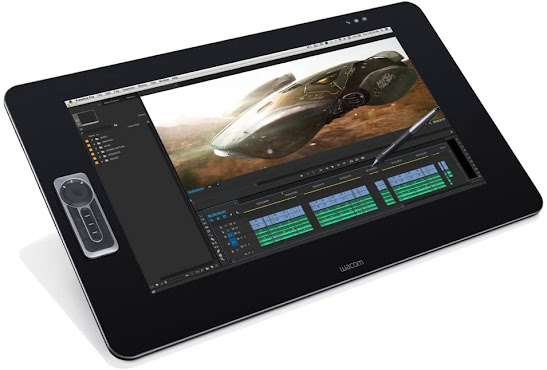Exercise 1: New Technologies of Hardware and Software
I. Hardware
1. Sony FX6 - The FX6 Cinema Line Camera puts revolutionary compactness and performance in the hands of creators, with its full-frame image sensor and breathtaking sensitivity. Leading-edge movie functions deliver game-changing performance and a library of cinematic looks, alongside pro interfaces and an electronic Variable ND Filter. Note: Operation of this equipment in a residential environment could cause radio interference.
2. Wacom Cintiq 27QHD - The DTH2700 Cintiq 27QHD 27" Creative Pen & Touch Display from Wacom features an AHVA LCD panel, which is Wacom's proprietary IPS technology. The panel allows for a 178° wide viewing angle, which allows you and anyone in your vicinity to fully appreciate the beauty of your work without the colors being washed out. The 27" display also features a QHD 2560 x 1440 native resolution and a 16:9 widescreen aspect ratio for higher resolution images while the 97% Adobe RGB wide gamut color boasts a panel of 1.07 billion colors. You can connect via HDMI or DisplayPort. However, DisplayPort is required if you want to experience the full QHD 2560 x 1440 resolution. This display also combines Wacom's advanced, pressure-sensitive pen technology with intuitive, multi-touch gestures to deliver an innovative on-screen creation experience.
3.Intel Core i9-9900K - Only compatible with their 300-series chipset-based motherboards, the Core i9-9900K 3.6 GHz Eight-Core LGA 1151 Processor from Intel is designed for gaming, creating, and productivity. It has a base clock speed of 3.6 GHz and comes with features such as Intel Optane Memory support, AES-NI encryption, Intel vPro technology, Intel TXT, Intel Device Protection with Boot Guard, Intel VT-d virtualization technology for directed I/O, and Intel Hyper-Threading technology for 16-way multitasking. With Intel Turbo Boost Max 3.0 technology, the maximum turbo frequency this processor can achieve is 5.0 GHz. Additionally, this processor features 8 cores with 16 threads in an LGA 1151 socket, has 16MB of cache memory, and 24 PCIe lanes. Having 8 cores allows the processor to run multiple programs simultaneously without slowing down the system, while the 16 threads allow a basic ordered sequence of instructions to be passed through or processed by a single CPU core. This processor also supports dual-channel DDR4-2666 RAM and utilizes 9th-generation technology.
II. Software
1. Blender - Blender is the free and open source 3D creation suite. It supports the entirety of the 3D pipeline—modeling, rigging, animation, simulation, rendering, compositing and motion tracking, even video editing and game creation. Advanced users employ Blender’s API for Python scripting to customize the application and write specialized tools; often these are included in Blender’s future releases. Blender is well suited to individuals and small studios who benefit from its unified pipeline and responsive development process. Examples from many Blender-based projects are available in the showcase.
3. Powtoon - Powtoon is a web-based animation software that allows users to create animated presentations by manipulating pre-created objects, imported images, provided music and user-created voice-overs.








Comments
Post a Comment